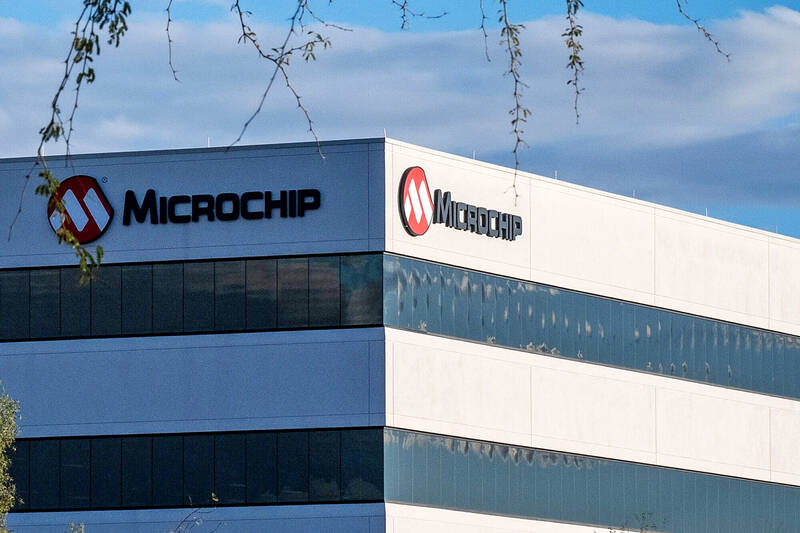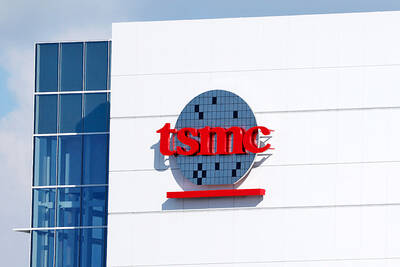Microchip Technology Inc is pausing its application for US semiconductor subsidies, making it the first known company to step back from a program designed to revitalize American chipmaking.
The struggling chipmaker was in line for US$162 million in grants from the CHIPS and Science Act to support plants in Oregon and Colorado. Since then, it has furloughed workers twice at facilities in Oregon and announced plans to shut down a factory in Arizona, affecting around 500 employees.
“I have put the negotiations with the CHIPS office on hold for now,” Microchip chief executive officer Steve Sanghi said on Tuesday at a UBS conference, confirming earlier reporting by Bloomberg. “Probably, by the time I get my arms around it, we’re into the new administration.”

Photo: Bloomberg
Microchip’s decision is a blow to US President Joe Biden’s officials racing to finalize awards from the landmark bipartisan law before president-elect Donald Trump’s return to the White House. The US Department of Commerce, which is in charge of CHIPS Act implementation, has announced preliminary deals with more than 20 companies, and inked final agreements with six — including major players like Intel Corp and Taiwan Semiconductor Manufacturing Co (台積電).
Those binding accords account for almost 50 percent of direct funding from the program, which set aside US$39 billion in grants — plus loans and tax breaks — to boost the US semiconductor industry after decades of production shifting to Asia. US Secretary of Commerce Gina Raimondo has said she wants to finalize as much of that money as possible before leaving office.
“We are in communication with Microchip on their CHIPS process and continue to have productive conversations with them about their long-term plans,” a commerce department spokesperson said in a statement. It is not clear whether the commerce department will reallocate the money set aside for Microchip.
Microchip, which makes older-generation chips for products like cars and consumer devices, has been mired in a deep sales slump and expects revenue to drop 40 percent this year. Its shares are down 27 percent this year, making it one of the worst performers on the Philadelphia Stock Exchange Semiconductor Index.
The company’s decision to pause the CHIPS Act process and shutter its Arizona plant highlights the cyclical nature of the semiconductor industry. The sector’s booms and busts present a challenge for policymakers, who are negotiating investments and subsidies that stretch years into the future.
“The grant was applied to maybe almost a year ago, when everybody thought that the factory capacity was never enough, and the world was gonna build silicon fabs forever,” Sanghi said on Tuesday. “Today, we have too much capacity.”
Meanwhile, CHIPS Act funding also only covers a small slice of factory costs. In order for companies to move forward with projects, the sites have to make commercial sense — something Biden officials have long recognized.
The “government gives you 15 cents of every dollar you spend,” Sanghi said on Tuesday. “Do I want to spend US$100 million to get US$15 million back from the government — if I don’t need it and I don’t want to spend the other 85 myself?”

Real estate agent and property developer JSL Construction & Development Co (愛山林) led the average compensation rankings among companies listed on the Taiwan Stock Exchange (TWSE) last year, while contract chipmaker Taiwan Semiconductor Manufacturing Co (TSMC, 台積電) finished 14th. JSL Construction paid its employees total average compensation of NT$4.78 million (US$159,701), down 13.5 percent from a year earlier, but still ahead of the most profitable listed tech giants, including TSMC, TWSE data showed. Last year, the average compensation (which includes salary, overtime, bonuses and allowances) paid by TSMC rose 21.6 percent to reach about NT$3.33 million, lifting its ranking by 10 notches

Popular vape brands such as Geek Bar might get more expensive in the US — if you can find them at all. Shipments of vapes from China to the US ground to a near halt last month from a year ago, official data showed, hit by US President Donald Trump’s tariffs and a crackdown on unauthorized e-cigarettes in the world’s biggest market for smoking alternatives. That includes Geek Bar, a brand of flavored vapes that is not authorized to sell in the US, but which had been widely available due to porous import controls. One retailer, who asked not to be named, because

SEASONAL WEAKNESS: The combined revenue of the top 10 foundries fell 5.4%, but rush orders and China’s subsidies partially offset slowing demand Taiwan Semiconductor Manufacturing Co (TSMC, 台積電) further solidified its dominance in the global wafer foundry business in the first quarter of this year, remaining far ahead of its closest rival, Samsung Electronics Co, TrendForce Corp (集邦科技) said yesterday. TSMC posted US$25.52 billion in sales in the January-to-March period, down 5 percent from the previous quarter, but its market share rose from 67.1 percent the previous quarter to 67.6 percent, TrendForce said in a report. While smartphone-related wafer shipments declined in the first quarter due to seasonal factors, solid demand for artificial intelligence (AI) and high-performance computing (HPC) devices and urgent TV-related orders

MINERAL DIPLOMACY: The Chinese commerce ministry said it approved applications for the export of rare earths in a move that could help ease US-China trade tensions Chinese Vice Premier He Lifeng (何立峰) is today to meet a US delegation for talks in the UK, Beijing announced on Saturday amid a fragile truce in the trade dispute between the two powers. He is to visit the UK from yesterday to Friday at the invitation of the British government, the Chinese Ministry of Foreign Affairs said in a statement. He and US representatives are to cochair the first meeting of the US-China economic and trade consultation mechanism, it said. US President Donald Trump on Friday announced that a new round of trade talks with China would start in London beginning today,